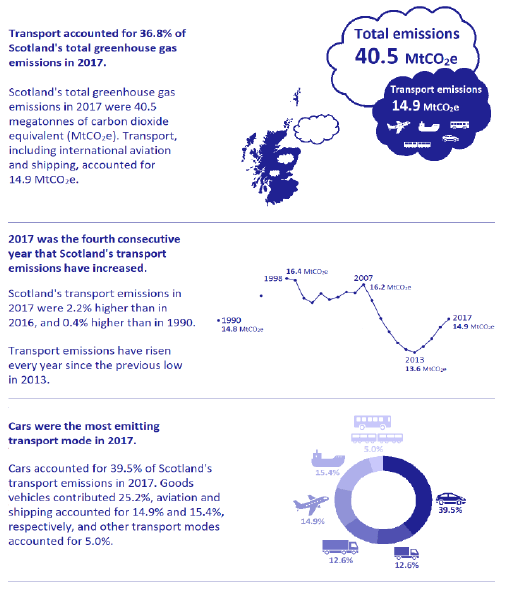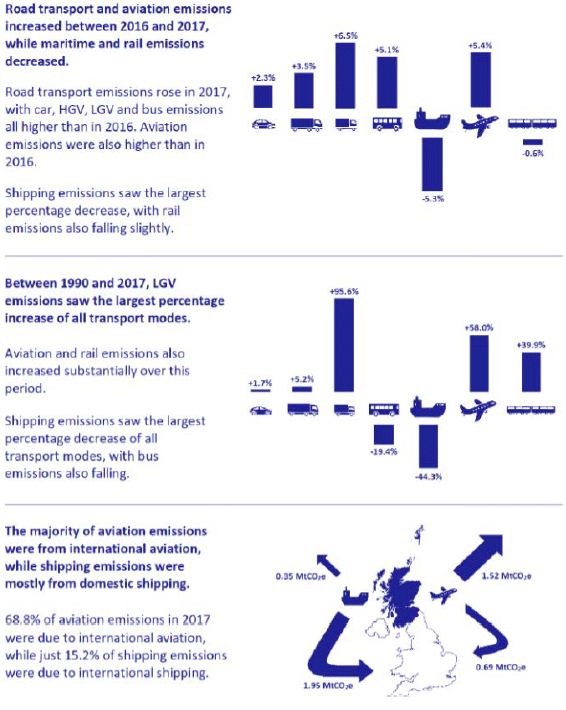Recent Social and Economic Research Reports
Recent Social and Economic Research Reports
Research reports published since the previous edition of “Scottish Transport Statistics” are listed below.
Title |
Seatbelt and Mobile Phone Usage Survey |
|---|---|
Publication date |
February 2019 |
Contractor |
In house |
Purpose of research |
Provides statistics on the proportion of vehicle occupants observed wearing seatbelts and drivers using mobile phones from a roadside observation survey commissioned jointly by Transport Scotland and the Department for Transport in 2017. The 2017 seatbelt survey resulted in 7,169 vehicle occupants being observed in Scotland, whilst the mobile phone survey recorded the behaviour of 14,427 drivers. |
Main findings |
97.3% of all drivers were recorded using a seatbelt in 2017, an increase from the 96.4% observed in 2014 the proportion of car drivers observed using their seatbelt correctly in 2017 was 98.6%, a marginal increase from the 97.8% recorded in 2014 rear seat passenger seatbelt usage has decreased, dropping from 99% in 2014 to 95.1%. However, this is largely driven by the inclusion of rear seat passengers in 'other vehicles' (vans, lorries, buses, coaches, and mini-buses) which have lower seatbelt rates overall and were excluded in the 2014 survey the proportion of car drivers observed using a mobile phone whilst driving was at 1.8% at moving (free-flowing) sites, a marginal increase from the 2014 figure (1.3%). At stationary (traffic light controlled junction) sites, the proportion observed using a mobile phone was 2.4%, an increase from 2014 figure (1.6%) the mobile usage rate at moving sites by drivers of 'other vehicles' (vans, lorries, buses, coaches, and mini-buses) was notably higher (3%) compared to car drivers (1.8%) at-ear mobile phone use has increased from 0.2% at both types of site in 2014 to 0.9% at moving sites and 1.2% at stationary sites |
Link to report |
https://www.transport.gov.scot/publication/seatbelt-and-mobile-phone-usage-survey-scotland-2017/ |
Title |
Evaluation of Road Safety Scotland’s Theatre in Education Performances |
|---|---|
Publication date |
August 2019 |
Contractor |
KSO Research |
Purpose of research |
This report presents the findings from an independent evaluation of the Theatre in Education (TiE) programme, commissioned by Transport Scotland. The evaluation sought to explore if the current TiE programme is fit for purpose in helping to protect children and young people. It also sought to explore value for money of the programme and provide recommendations about how the programme and performances can be improved. |
Main findings |
Overall, feedback for each performance was very positive, and audiences appeared to engage well, commenting positively on both content and mode of delivery. There was very little that audiences suggested could be done to improve the performances except, perhaps, some streamlining of messages and making shows even more interactive (especially for school audiences). Despite very positive feedback, however, the evaluation showed that there was no measurable impact on attitudes to road safety risks or on self-reported frequency of engaging in risky road safety behaviours. For school pupils, this was largely because audiences were already confident in their road safety awareness and felt that they were ‘safe’ in their current behaviours. For the community performance, although it was not possible to evaluate impact per se, a broad demographic of audience members took part in the research and again, provided positive feedback. Teachers reported positively on the programme at all levels of the curriculum, and delivery of road safety messages by a touring theatre company was particularly welcomed by schools. Teaching staff indicated that pupils preferred this particular mode of delivery and especially liked the relatability of the performances for pupils (which was reiterated by pupils themselves). Learning professionals confirmed that there was little other road safety education delivery at any of the stages targeted by the performances, especially at secondary level. There was also negligible follow-up activity for the performances in schools. Learning professionals suggested that, if the programme were removed, other competing priorities, as well as a lack of space in the curriculum, may mean that road safety messages are not delivered at all. Local authority representatives, including Road Safety Teams and education contacts, provided unanimous support for the theatre programme. They endorsed many of the views of learning professionals regarding the quality of the programme and the positive engagement demonstrated by audiences. They also reiterated that, without the programme, schools were unlikely to receive alternative provision, due to limited resources and competing priorities for local authority staff, including those with designated road safety roles. Understanding of the content of performances was clear, with no ambiguity about the road safety themes being conveyed. Relatability was seen as a real strength of all tours and the use of humour, empathy and emotional impact to draw people into the performances seem to work well. All plays resonated with their target audiences, giving age appropriate messages. Recall was also strong in the short term and both school and community audiences alike welcomed theatre as a mode of delivery. This was especially true for older school pupils and communities where exposure to educational drama of this kind was described as limited Other than reducing the reach of the TiE programme, the evaluation showed that there appears to be little scope for cost savings - money is already spent efficiently, and there are few costs incurred beyond the core RSS allocation. Added value is achieved from the guaranteed reach that theatre provides when compared to online and printed resources, i.e. captive audiences. There is also a strong probability, based on learning from the research, that if TiE was removed or reduced, it would not be replaced with alterative provision by schools or local authorities themselves. Indeed, there was nothing to suggest that local authorities or individual schools would proactively explore options to fill a gap left by TiE if this occurred, as competing priorities in the curriculum alongside limited local authority budgets means that other activities are prioritised. The value in retaining TiE, although not measurable, is that this situation of ‘no provision’ is avoided. |
Link to report |
Title |
Carbon Account for Transport No. 11: 2019 |
|---|---|
Publication date |
September 2019 |
Contractor |
In house |
Purpose of research |
The Carbon Account for Transport (CAT) is published annually, and presents a detailed analysis of already published transport emissions data for Scotland. This is the eleventh edition of the CAT, and includes a detailed analysis of the latest emissions data (1990-2017), published by the National Atmospheric Emissions Inventory in June 2019 |
Main findings


Link to report |
https://www.transport.gov.scot/publication/carbon-account-for-transport-no-11-2019-edition/ |
|---|
Title |
Transporting Scotland’s Trade 2019 Edition |
|---|---|
Publication date |
October 2019 |
Contractor |
In House |
Purpose of research |
This 2019 edition of Transporting Scotland's Trade provides a summary of Scotland's key exports and imports; how they are transported to, from and within Scotland; and an overview of some of Scotland's key transport hubs and trading partners |
Main findings |
Scotland traded (imports and exports) over £57.6 billion worth of goods in 2018, 56% of which were exports. Of the £32.2 billion worth of goods exports destined for international markets, £17.3 billion worth (54%) went to the EU. The top 5 destinations for Scottish exports in 2018 were the Netherlands, the United States, Germany, the Republic of Ireland, and France. Scotland's key export markets include 'Petroleum, petroleum products & related materials', 'Beverages' and 'Power generating machinery & equipment' – these three commodity groups combined accounted for 57% of the value of Scottish goods exports in 2018. In 2018, total freight (road, port and air) carried in Scotland was approximately 214 million tonnes. Road freight made up the largest proportion (69%) followed by port (31%) and then air (<1%). The majority of freight lifted in Scotland was carried by HGV on the road network and remained within Scotland (111.4 million tonnes). Although the amount of road freight carried from Scotland to mainland Europe is small (less than 200,000 tonnes), the road network between Scotland and Europe continues to be an essential way to transport perishable goods to market. Scotland's rail freight network, carried freight around 430 million net tonne miles between April 2018 and March 2019. Forth Ports is Scotland's largest port with 26.6 million tonnes being handled in 2018. Clyde Ports boasts the deepest sea entrance in Northern Europe and is the busiest cruise terminal in Scotland. Cairnryan/Loch Ryan is Scotland's main port for carrying goods and passengers to Northern Ireland. In 2018, all passenger travel by ferry to Northern Ireland went via Cairnryan. Edinburgh and Glasgow were in the UK top 10 airports for both terminal passengers (6th and 8th respectively) and freight lifted (9th and 10th respectively) in 2018. Scotland's largest intermodal rail freight terminals are across the central belt – Coatbridge, Grangemouth and Mossend. Scotland's number one international export destination is the Netherlands. This is largely due to the Dutch port of Rotterdam being an international shipping hub with goods exported to other global destinations from there. In 2018, the USA was Scotland's main non-EU export destination with whisky being a key export commodity. Although most high density freight to the USA is carried by ship, direct flights operate from Scotland, carrying low volume/high value freight. In 2018, the Republic of Ireland replaced China as one of Scotland's top 5 exporting destinations. £1.5 billion of exports went to the Irish Republic, accounting for 3.5% of Scotland's total exports. A share of these goods would have been transported via the 13 daily sailings from Cairnryan / Loch Ryan to Belfast and Larne. Since 2013, Scotland has imported more goods from Norway than any other nation. Between 2013 and latest available data (2019 Q2), imports from Norway have totalled more than £25.5 billion. As a result of both countries involvement in the North Sea oil and gas fields, the top categories are related to petroleum and gas. These are typically transported by either boat or pipeline. |
Link to report |
https://www.transport.gov.scot/publication/transporting-scotlands-trade-2019-edition/ |